Paddling with petroglyphs: Kayaking in Murujuga National Park, WA

With her laser pointer, Sarah Hicks, a young Murujuga land and sea ranger, is pinpointing a rock carving of a fat-tailed kangaroo. When she explains this species has been extinct for many thousands of years, I feel my goosebumps rise. This portal into the distant past is a mountainside composed entirely of rusty, blocky boulders. Many of the rocks host carvings, etchings and scrapings, known as petroglyphs; Indigenous rock art dating back as far as 50,000 years.
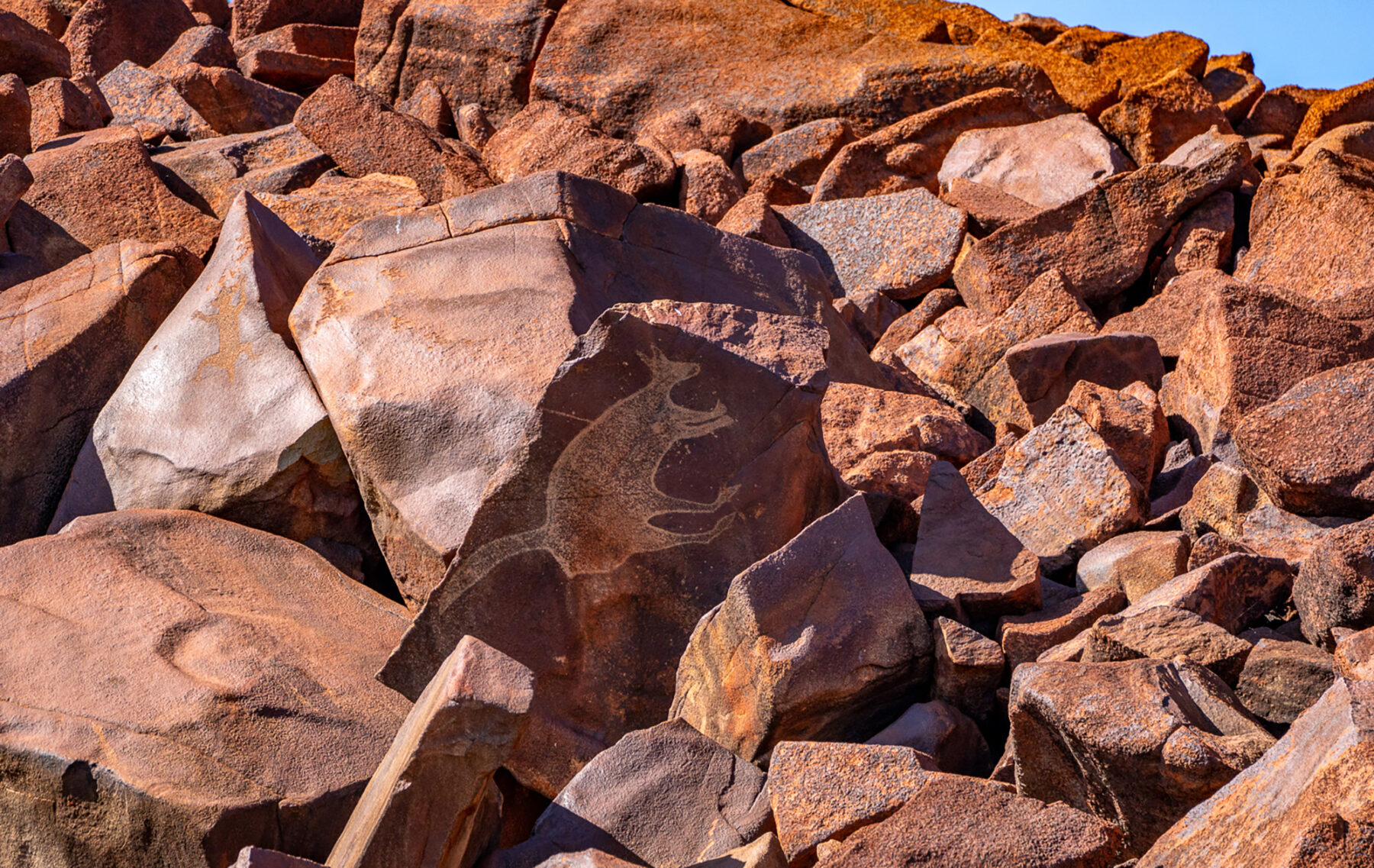
Alongside the fat-tailed kangaroo is the Tasmanian tiger, absent from this landscape for some 6000 years, along with animals that remain here, like the northern quoll, snakes and emus. Others images depict spears, waterholes and human-like spirits. Sarah’s colleague, Jade Churnside, points out traditional medicine and food plants, and shows us grinding stones, used to make a bush bread from spinifex seeds.
A cultural landscape
I’m at Ngajarli (Deep Gorge) in Murujuga National Park, near Dampier, 1500 kilometres north of Perth. This staggering place is said to be home to the biggest collection of rock art in the world, with up to two million petroglyphs in the area. Song lines and legends link this place through the Western Desert to Uluru, and further east into Victoria.
Given its significance, it’s incredible how few visitors come here. Located on the Burrup Peninsula, it’s an area better known as an industrial hub, the tourism potential overshadowed by infrastructure supporting the export of gas, iron ore, fertiliser and salt. But as I discover, if you step outside the industrial footprint, a treasure trove of wonders awaits.
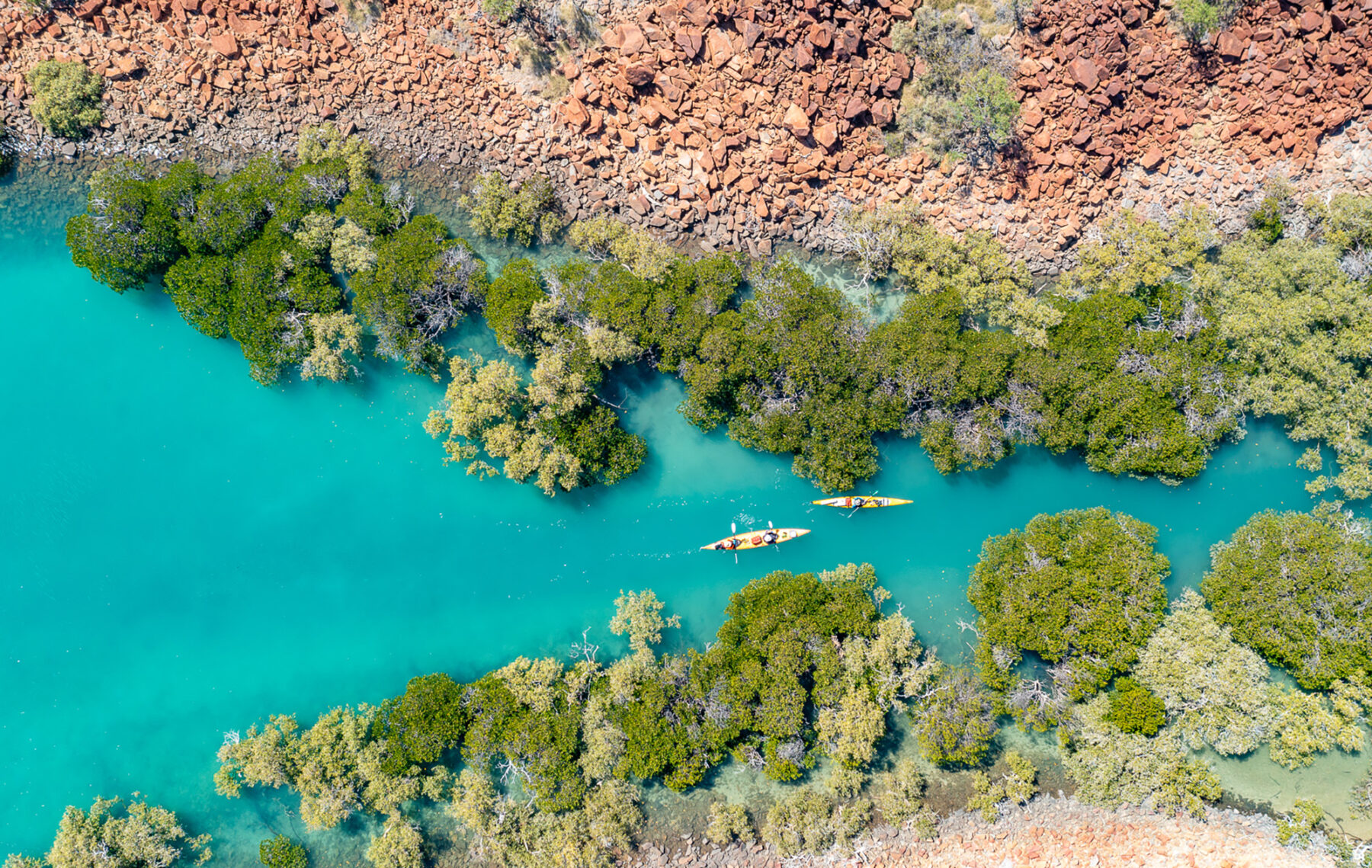
I’ve joined a five-day Murujuga expedition kayak trip with Exmouth Adventure Co., and day one has started with this cultural awareness programme. Murujuga is the first national park in Western Australia to be co-managed, with the government and the Murujuga Aboriginal Corporation (MAC) sharing responsibilities. To understand further, our next stop is the MAC headquarters, where we meet Indigenous ranger coordinator, Peter Cooper.
Peter says MAC is guided by a circle of elders (including himself) representing five traditional Indigenous language groups: the Ngarluma, the Mardudhunera, the Yaburara, the Yindjibarndi, and the Wong-Goo-Tt-Oo.
While the national park protects 5134 hectares of the Burrup Peninsula, Australian National Heritage listing includes some 37,000ha across the Burrup and many of the 42 islands of the Dampier Archipelago. This larger area is being used as the starting point for an application for World Heritage listing, and MAC hopes Murujuga will be World Heritage listed in 2025.
As we learn, the artworks at Ngajarli are just the tip of the petroglyph iceberg. When people first started carving here, millennia ago, the coastline was 100km further out to sea, and today’s islands were mainland hills. Through various ice ages and sea levels changes, people have thrived here, and continued to carve.
The cultural landscape of Murujuga encompasses up to two million petroglyphs, across the mainland and islands, and to see more of them, we’ll need to take to the sea. This is where the kayaks come in.
Island adventures
I’ll be paddling and camping through these islands for five days. While the company runs most of its tours at Ningaloo Reef, in 2023 Exmouth Adventure Co. launched its new expeditions here. Aside from Indigenous culture, this place has striking landscapes, prolific birdlife, and the richest marine biodiversity in Western Australia.
Our group consists of just three guests, guides Neri Grieve and Neil Brown, and off-duty guide, Kayleigh Brown. As the winds and currents here can be a factor, the trip is aimed at experienced kayakers, and we’re paddling two double and two single kayaks. Now, with our heads packed full of culture, we’re jamming our kayaks full of camping gear, food, and water, and paddling into the adventure.
Proceeding north up the Burrup Peninsula, we’re leaving the heavy industry behind. Our paddling rhythm is relaxed, and with a few kilometres under our belts, our first stop is on a gorgeous crescent of beach at Conzinc Bay.
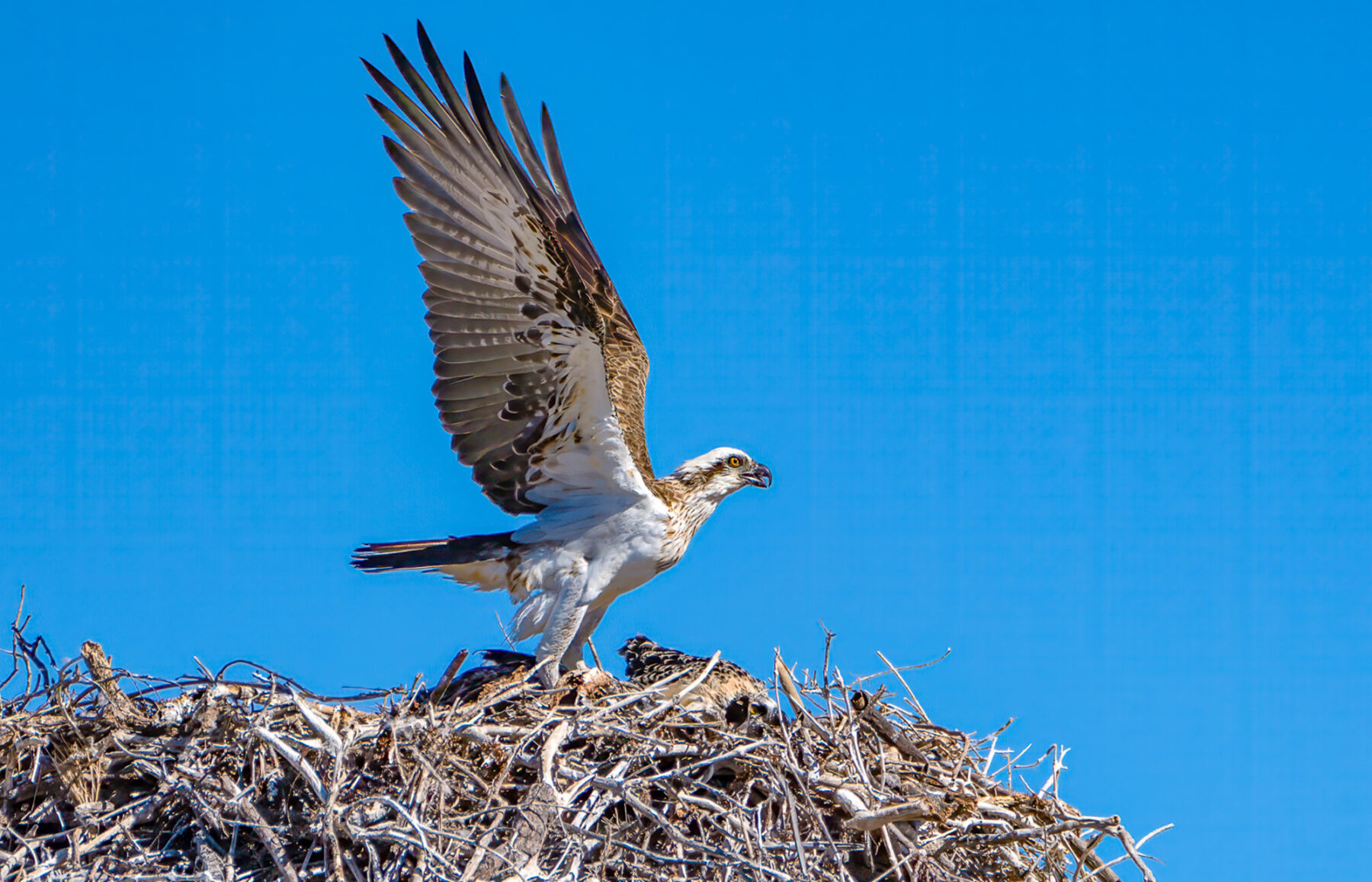
In a tiny beach shelter, Neri and Neil prepare the first of many buffet-style picnics for us, featuring freshly made salads, cold meats and falafel balls. Throughout this trip, I’ll be constantly amazed at the healthy and delicious meals that result from our kayak stores.
While they’re chopping and dicing, Neri suggests we explore the mangrove creek on foot. Here we find the remnants of a fish trap, with rocks to catch fish that washed in on a high tide. The rocky outcrop at the entrance to the creek is marked with petroglyphs of humans, perhaps hunting a huge fish in this very trap. Elsewhere, we spot engraved leatherback turtles.
Leaving the mainland, we’re crossing to the southern tip of Angel Island, accompanied by Australian humpback dolphins. Several turtles pop their heads up, and a shy dugong is startled by our presence.
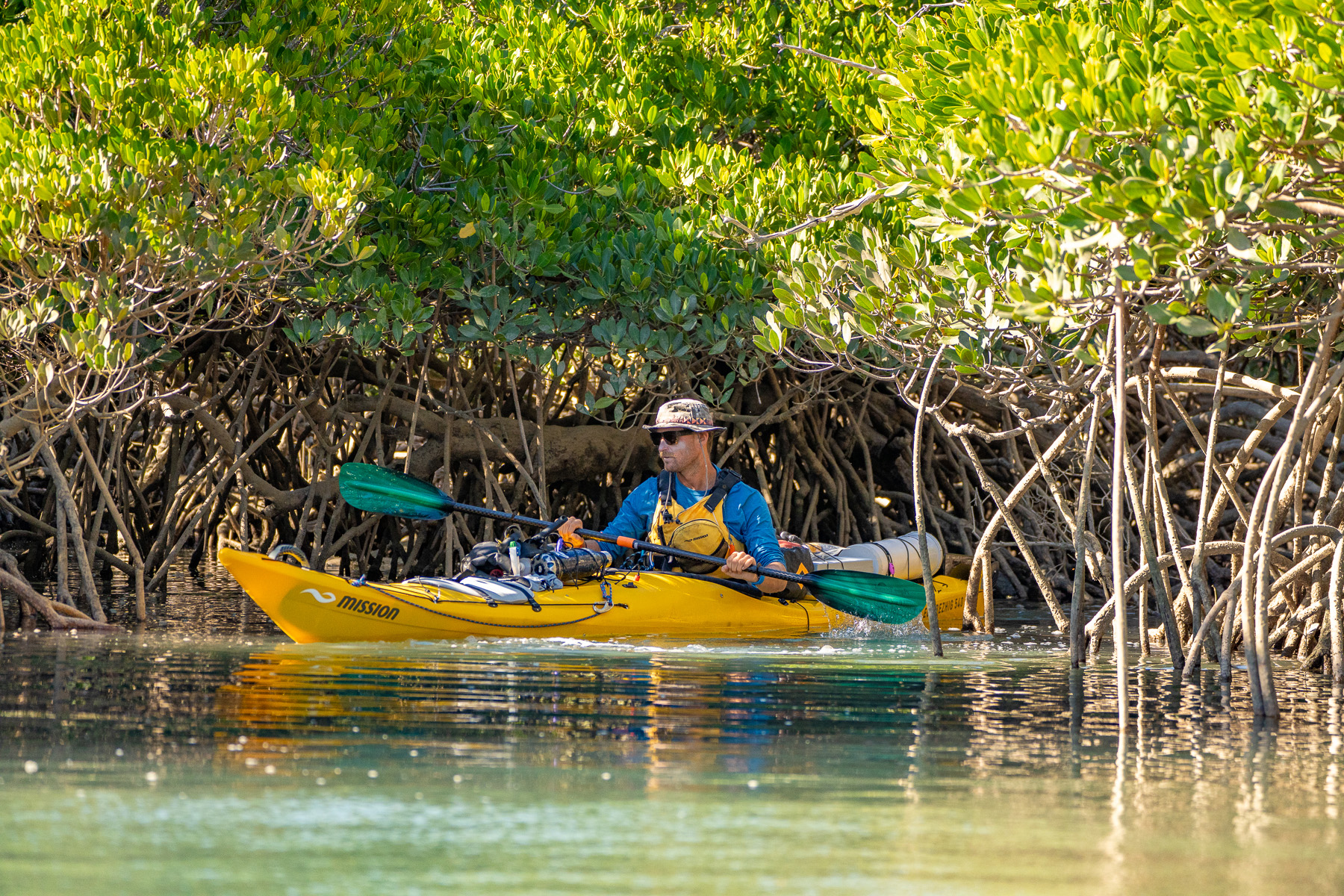
Angel Island is one of 25 islands here that comprise a nature reserve. Almost untouched, the islands have no facilities, walking tracks, or phone coverage. As soon as we’re amongst the islands, we feel like we’re on another planet.
If Angel Island is another planet, it might well be Mars, as the geology here is certainly glowing red in the late afternoon sun. We glide along silently in the shelter of the island, staring up at rocky, rusty cliffs. They’re offset against dazzling, white beaches, and a vibrant, turquoise ocean. Our only company here is the wildlife, and we’re regarded with suspicion by nesting ospreys, Caspian terns, and pied oyster catchers.
We pull into a bay that’s unnamed on our map, and agree that to us, this will be Sunset Bay. We assemble our tents along the beach, just in time to enjoy a cheese platter and cold beer as the sun slumps into the sea.
The next morning, the pre-dawn sky is tinged with mauve. From my tent, I see a flock of terns dive-bombing the ocean surface, which is boiling from beneath, a school of fish being attacked from above and below. Climbing a sand dune, I see the first golden rays highlight the fuzzy grey bushes and hardy clumps of spinifex.
Down below, Neil waves to me and holds up the coffee pot. Soon I’m fuelling up on porridge, fruit salad, yoghurt and toast. Neri delivers our morning briefing, and we’re back on the ocean, excited by the possibilities.

Rounding a rocky headland into yet another superb bay, the water is crystal clear revealing tabletop and boulder corals and myriad busy reef fish.
“We’d be mad not to jump in for a snorkel,” Neri says.
I grab my mask, snorkel and fins, which are strapped to the front of my kayak, waiting for their time in the briny. Massive boulders from the landscape above continue underwater, and in the shadow of one, we find a snoozing tawny nurse shark. Butterfly fish and a juvenile black tip reef shark delight us, and under corals, we find lobsters.
Remounting the kayak from deep water requires a particular technique Neri calls the ‘sunbathing dugong manoeuvre’. Kicking my fins, I push up to flop belly first across the kayak cockpit, then rotate my backside around, and I’m in, dripping wet and laughing.
We settle into a routine of leisurely paddling, up to about 18km a day, with plenty of beach stops. Sometimes we chat, but often there’s easy silence, each of us lost in a reverie, tuned into the sounds of nature; bird calls, fish splashing, or a turtle’s breath.
Our guides insist that this is our trip. The itinerary is fluid, and we’re encouraged to linger anywhere that piques our interest. When we come to large tracts of mangrove forest, we take a slow ‘mangrove meander’. The tangle of aerial roots provides sheltered habitat for turtles, rays and baby reef sharks, and we point them out to each other as they rocket away. Sometimes, there are too many to bother.
Generations gone by
Across the islands we come across other reminders of earlier inhabitants. Standing stones, erected to signify important resources and ceremonial places are silhouetted on ridgetops. In many places we choose to camp, we see that others have stayed here too, with middens on the beach containing oyster and bailer shells, and many stone tools. And the petroglyphs are ubiquitous, documenting the natural world, the lifeblood of these tribes.
Remembering Peter’s advice, there are some things we don’t photograph, and places we don’t enter. Beside one mangrove-lined inlet, a huge petroglyph depicts a male figure holding up a palm. This may be a sacred men’s area, so we continue past.

There’s European history through these islands, too. The Dampier Archipelago was the heart of the WA pearling industry from 1870 to 1900, before the fleet moved north to Broome. We stop by the remnants of a pearling camp in Black Hawke Bay, and on Dolphin Island we visit six grave sites, believed to be pearlers.
The pearlers were known to enslave Aboriginal men, women and children, and before we paddle across Flying Foam Passage, Neri tells us the sobering story of the 1868 massacre of the Yaburara Aboriginal people that occurred here. Together with smallpox and other illnesses, this massacre effectively obliterated this language group.
Saddened by this, we soon turn our attention back to the petroglyphs and wildlife. We have many encounters with large marine animals. I almost snorkel into three whip-tailed rays, submerged in the sand with long, skinny tails protruding, and a two-metre-long lemon shark inspects me at close range, in knee-deep water.
The mightiest of all are the humpback whales. Having glimpsed them splashing in the moonlight the night before, we’re now paddling out to the whale highway. Soon, we’re seeing the blow of a mother and her last-year’s baby. We maintain a very respectful distance, but suddenly the whales surface some 20 metres in front of us. As the mother slowly ushers the baby away, it makes a half-breach. From the front seat of my kayak, I feel incredibly small, and almost overcome with awe and gratitude for this moment.
Neri paddles us past a place she calls the Art Gallery. Here in this sheltered bay we simply drift, staring at a boulder hillside adorned with huge kangaroos, fish, and turtles. There are humpback whales, mid-breach, captured in stone.
My mind wanders back to our induction with Peter on day one. He’d said that in this passage, 14 metres underwater, archaeologists had found a freshwater stream. Stone tools are down there too, left behind by the artists that carved here, before the last sea level rise. I picture this artwork continuing, down to the inky depths.
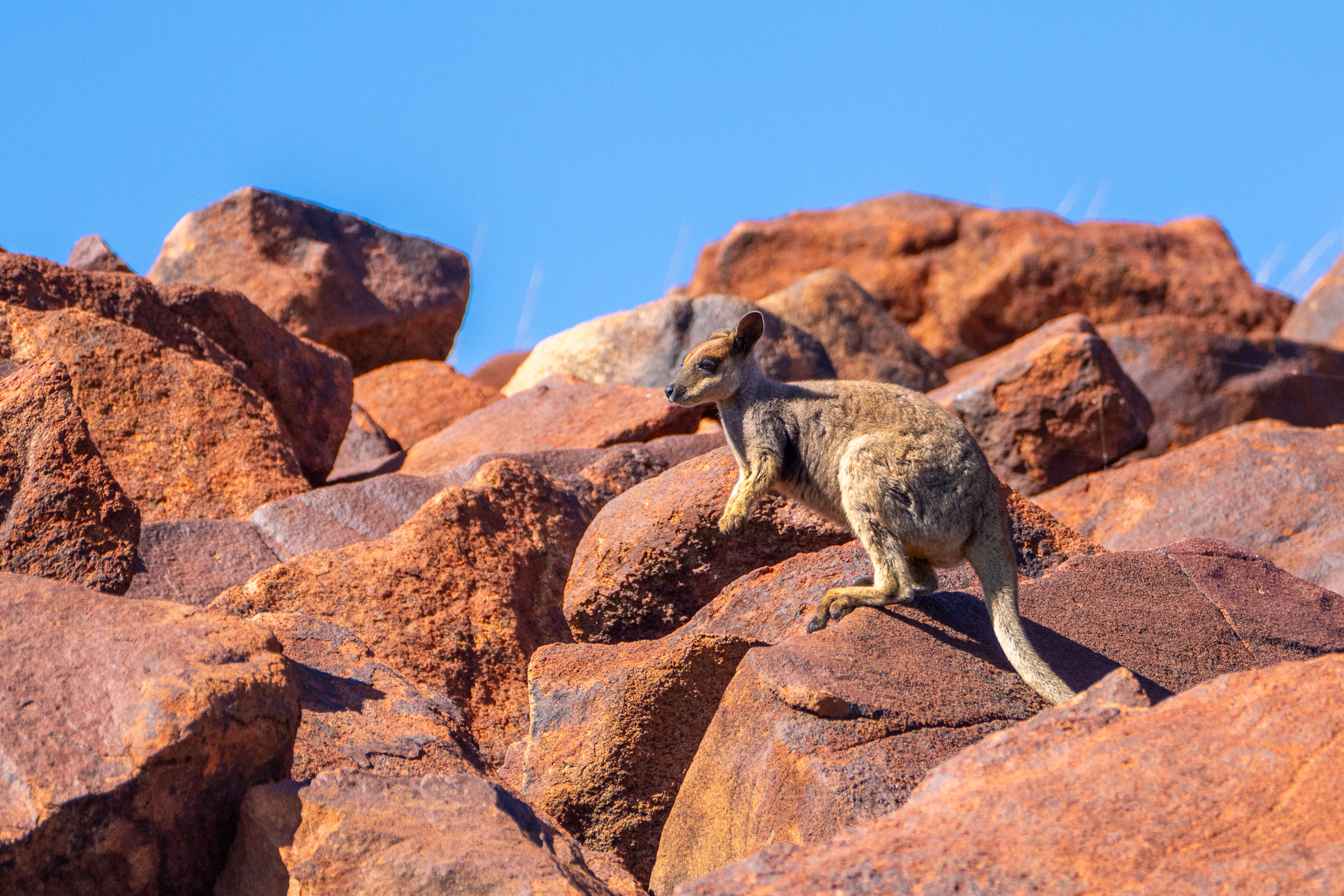
It’s spooky how often that art mimics life. At one point, 20 or 30 turtles buzz under our kayaks. We glance up at the coastline, and see images of turtles, engraved on the rocks. It’s staggering to think this has probably been a known turtle hotspot for thousands of years.
Another day, I spot a Rothchild’s rock wallaby, effortlessly bouncing across the rocks, high up a hill. Hoping to take a closer look, I hike up a dry creek bed lined with spindly, white-trunked bloodwoods. I pass a dry waterhole, its surrounding walls adorned with hunters, stingrays, snakes, and a hammerhead shark.
Zig-zagging uphill, I finally stand atop this boulder mountain, taking in the vast ocean, and our campsite far below. There are no wallabies to be found, except a one-metre-wide wallaby petroglyph, emblazoned on the rock.
Civilisation calls
On our fifth night, we all feel the weight of the return to civilisation. Phones start to buzz, and Neri points out the faint glow of Dampier on the horizon.
“Look, the Aurora Industrialis,” she says.
On our final paddle, we’re returning to Withnell Bay, and I’m not relishing the idea of being back. On the positive side, I’m looking forward to a shower, and reflecting on how lucky I am to have been immersed in Murujuga, with its rugged beauty, its rich wildlife and its staggering art.
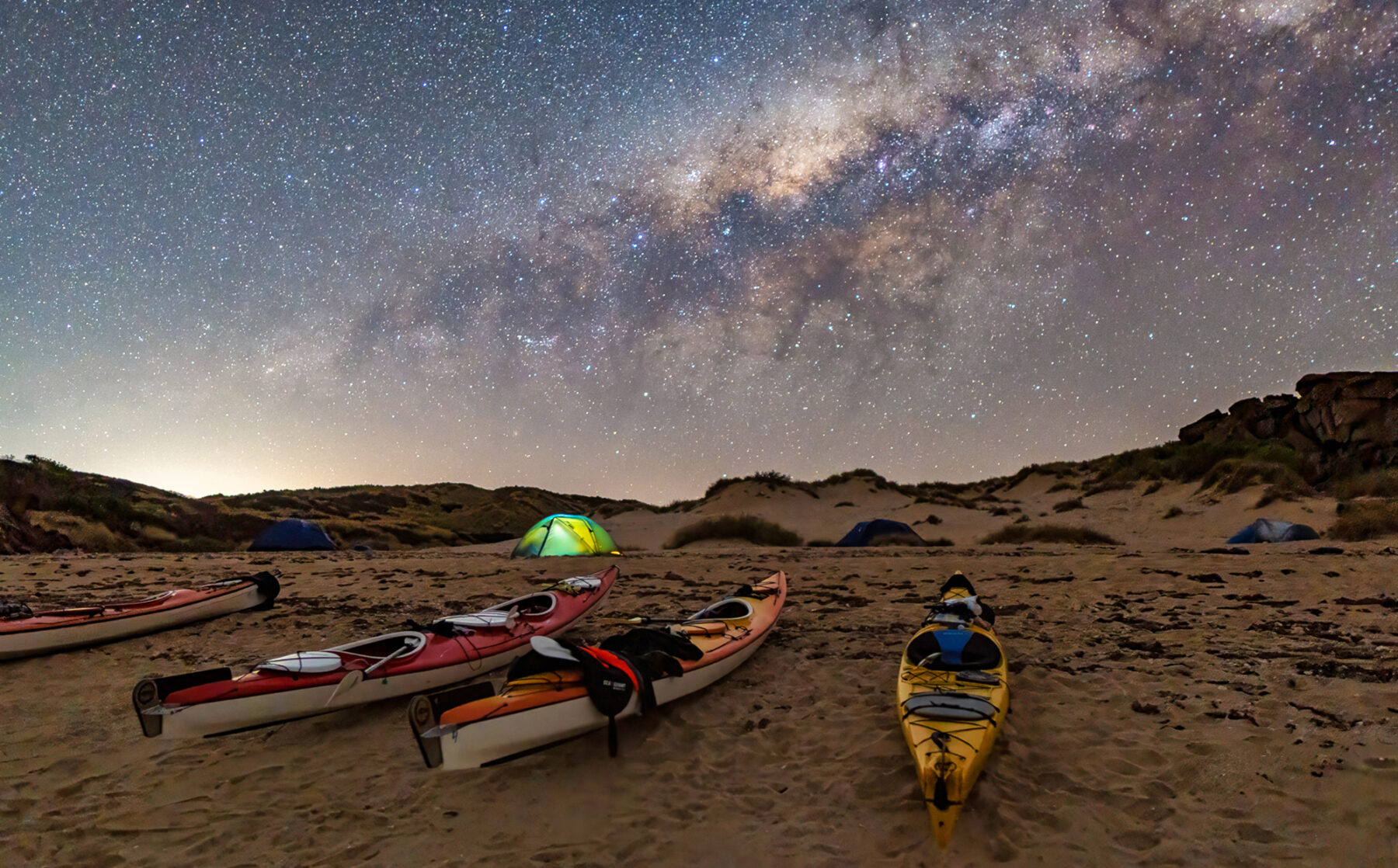
I’m pinning my hopes on World Heritage listing delivering protection of this area for the next 50,000 years. This is something that all Australians, present and future generations, should know about. It’s our unique cultural heritage, a place worth cherishing.
The writer travelled as a guest of Exmouth Adventure Co. and Tourism Western Australia




